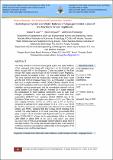| dc.description.abstract | The study aimed to unveil the hydrological system and water balance
of the ungauged crater lakes with major focus on the Emakati Lake
which occupy 46% of the Empakaai Crater associated to the East
African Rift Valley and form part of the Northern Crater Highlands.
Water samples for analysis of NO3- , Cl- and stable isotopes (2H and
18O) were collected from the Emakat lake, springs of the inner, outer
and the foot of the Empakaai Crater rims. A combination of satellite
data such as digital elevation model (DEM), Climate Hazards Group
Infrared Precipitation with Station data (CHIRPS), net shortwave solar
radiation, surface temperature, and the computation methods such as
Curve Number (CN) Model, DeBruin–Keijman (D-K) Model enabled
the computation of water balance components such as Lake level
changes, precipitation, runoff and evaporation. Results show that,
evaporation (1694.57 mm) surpasses rainfall (878.68 mm) of the
Empakaai Crater results of higher enrichments of δ18O and δ2H in the
lake ranging between 3.28⁰/₀₀ to 3.96⁰/₀₀ and 31.99 to 33.93⁰/₀₀
compared to springs which range between -5.18 to -4.05⁰/₀₀ and -26.62
to -19.48⁰/₀₀ respectively. Springs plots to the left and above of both the
GMWL and TMWL, implying that they receive direct recharge from
rainfall. The water balance in the area shows that, groundwater flow
plays a major role on the lakes hydrological system as it contributes
about 22,004,361.12 m3/year as the groundwater inflow to Emakat
Lake which is about 56% of the lake’s total inflow and about
22,734,274.00 m3/year as groundwater outflow which is about 63% of
total lake outflow. This imply that, the lake depends less on the weather
condition and hence ensuring the sustainability of the ecosystem of the
Empakaai crater and the downstream. | en_US |

